Today, of course, we’re going to talk about the announcement from the Event Horizon Telescope and the first photograph of a black hole’s event horizon.
Continue reading “Ep. 526: Event Horizon Telescope and the Black Hole at M87”
Today, of course, we’re going to talk about the announcement from the Event Horizon Telescope and the first photograph of a black hole’s event horizon.
Continue reading “Ep. 526: Event Horizon Telescope and the Black Hole at M87”

“We have taken the first picture of a black hole.”
EHT project director Sheperd S. Doeleman of the Center for Astrophysics | Harvard & Smithsonian.
What was once un-seeable can now be seen. Black holes, those difficult-to-understand singularities that may reside at the center of every galaxy, are becoming seeable. The Event Horizon Telescope (EHT) has revealed the first-ever image of a black hole, and with this image, and all the science behind it, they may help crack open one of the biggest mysteries in the Universe.
Continue reading “It’s Finally here. The First Ever Image of a Black Hole”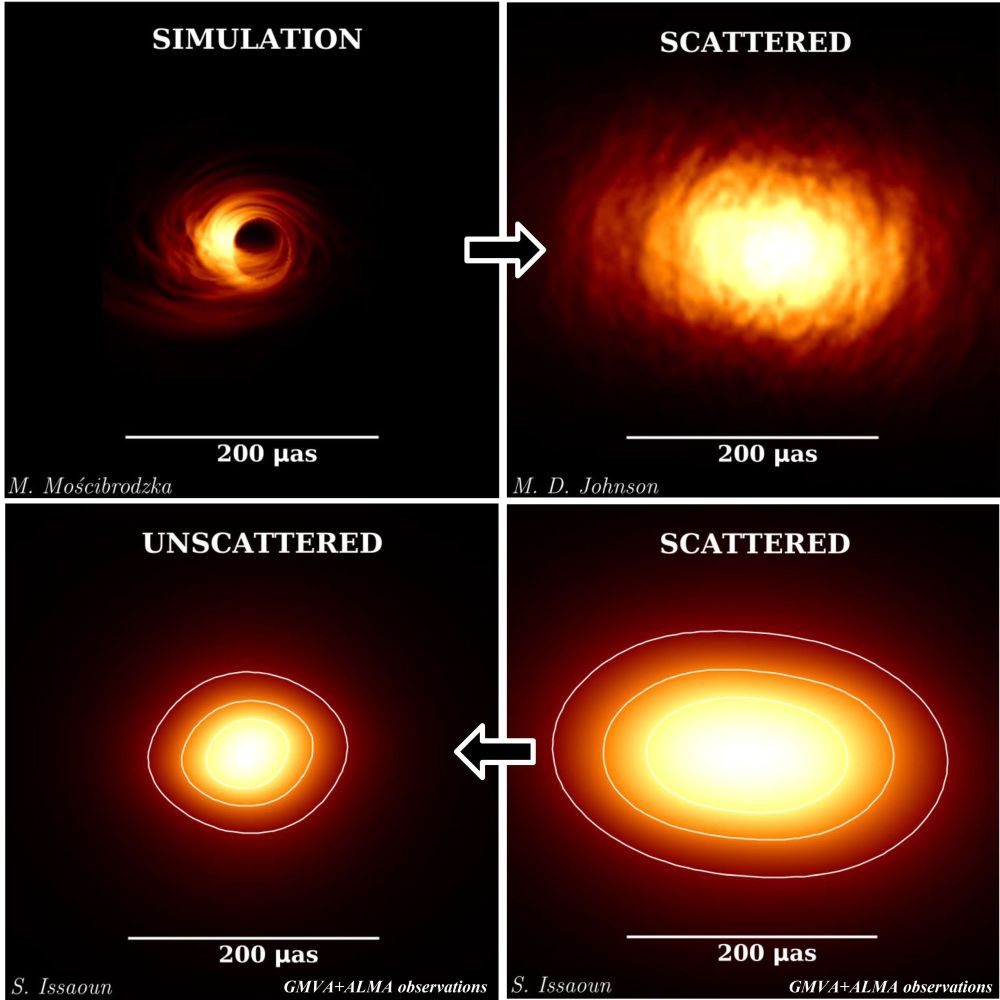
An almost unimaginably enormous black hole is situated at the heart of the Milky Way. It’s called a Supermassive Black Hole (SMBH), and astronomers think that almost all massive galaxies have one at their center. But of course, nobody’s ever seen one (sort of, more on that later): It’s all based on evidence other than direct observation.
The Milky Way’s SMBH is called Sagittarius A* (Sgr. A*) and it’s about 4 million times more massive than the Sun. Scientists know it’s there because we can observe the effect it has on matter that gets too close to it. Now, we have one of our best views yet of Sgr. A*, thanks to a team of scientists using a technique called interferometry.
Continue reading “One of Our Best Views of the Supermassive Black Hole at the Heart of the Milky Way”Shortly after Einstein published his Theory of General Relativity in 1915, physicists began to speculate about the existence of black holes. These regions of space-time from which nothing (not even light) can escape are what naturally occur at the end of most massive stars’ life cycle. While black holes are generally thought to be voracious eaters, some physicists have wondered if they could also support planetary systems of their own.
Looking to address this question, Dr. Sean Raymond – an American physicist currently at the University of Bourdeaux – created a hypothetical planetary system where a black hole lies at the center. Based on a series of gravitational calculations, he determined that a black hole would be capable of keeping nine individual Suns in a stable orbit around it, which would be able to support 550 planets within a habitable zone.
He named this hypothetical system “The Black Hole Ultimate Solar System“, which consists of a non-spinning black hole that is 1 million times as massive as the Sun. That is roughly one-quarter the mass of Sagittarius A*, the super-massive black hole (SMBH) that resides at the center of the Milky Way Galaxy (which contains 4.31 million Solar Masses).
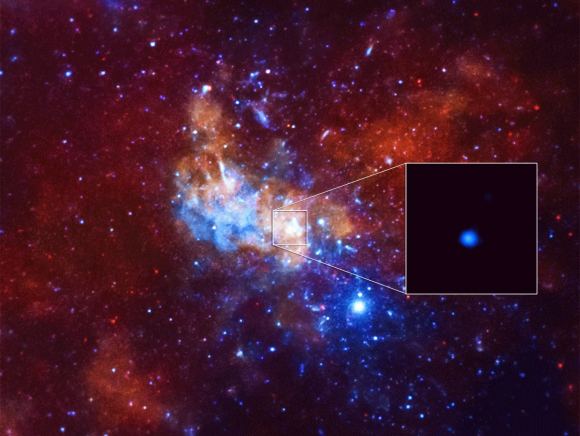
As Raymond indicates, one of the immediate advantages of having this black hole at the center of a system is that it can support a large number of Suns. For the sake of his system, Raymond chose 9, thought he indicates that many more could be sustained thanks to the sheer gravitational influence of the central black hole. As he wrote on his website:
“Given how massive the black hole is, one ring could hold up to 75 Suns! But that would move the habitable zone outward pretty far and I don’t want the system to get too spread out. So I’ll use 9 Suns in the ring, which moves everything out by a factor of 3. Let’s put the ring at 0.5 AU, well outside the innermost stable circular orbit (at about 0.02 AU) but well inside the habitable zone (from about 2.7 to 5.4 AU).”
Another major advantage of having a black hole at the center of a system is that it shrinks what is known as the “Hill radius” (aka. Hill sphere, or Roche sphere). This is essentially the region around a planet where its gravity is dominant over that of the star it orbits, and can therefore attract satellites. According to Raymond, a planet’s Hill radius would be 100 times smaller around a million-sun black hole than around the Sun.
This means that a given region of space could stably fit 100 times more planets if they orbited a black hole instead of the Sun. As he explained:
“Planets can be super close to each other because the black hole’s gravity is so strong! If planets are little toy Hot wheels cars, most planetary systems are laid out like normal highways (side note: I love Hot wheels). Each car stays in its own lane, but the cars are much much smaller than the distance between them. Around a black hole, planetary systems can be shrunk way down to Hot wheels-sized tracks. The Hot wheels cars — our planets — don’t change at all, but they can remain stable while being much closer together. They don’t touch (that would not be stable), they are just closer together.”
This is what allows for many planets to be placed with the system’s habitable zone. Based on the Earth’s Hill radius, Raymond estimates that about six Earth-mass planets could fit into stable orbits within the same zone around our Sun. This is based on the fact that Earth-mass planets could be spaced roughly 0.1 AU from each other and maintain a stable orbit.
Given that the Sun’s habitable zone corresponds roughly to the distances between Venus and Mars – which are 0.3 and 0.5 AU away, respectively – this means there is 0.8 AUs of room to work with. However, around a black hole with 1 million Solar Masses, the closest neighboring planet could be just 1/1000th (0.001) of an AU away and still have a stable orbit.
Doing the math, this means that roughly 550 Earths could fit in the same region orbiting the black hole and its nine Suns. There is one minor drawback to this whole scenario, which is that the black hole would have to remain at its current mass. If it were to become any larger, it would cause the Hill radii of its 550 planets to shrink down further and further.
Once the Hill radius got down to the point where it was the same size as any of the Earth-mass planets, the black hole would begin to tear them apart. But at 1 million Solar masses, the black hole is capable of supporting a massive system of planets comfortably. “With our million-Sun black hole the Earth’s Hill radius (on its current orbit) would already be down to the limit, just a bit more than twice Earth’s actual radius,” he says.
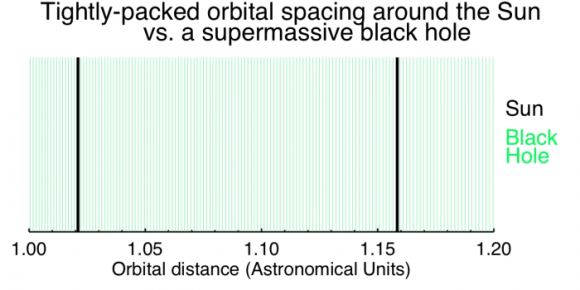
Lastly, Raymond considers the implications that living in such a system would have. For one, a year on any planet within the system’s habitable zone would be much shorter, owing to the fact their orbital periods would be much faster. Basically, a year would last roughly 1.6 days for planets at the inner edge of the habitable zone and 4.6 days for planets at the outer edge of the habitable zone.
In addition, on the surface of any planet in the system, the sky would be a lot more crowded! With so many planets in close orbit together, they would pass very close to one another. That essentially means that from the surface of any individual Earth, people would be able to see nearby Earths as clear as we see the Moon on some days. As Raymond illustrated:
“At closest approach (conjunction) the distance between planets is about twice the Earth-Moon distance. These planets are all Earth-sized, about 4 times larger than the Moon. This means that at conjunction each planet’s closest neighbor appears about twice the size of the full Moon in the sky. And there are two nearest neighbors, the inner and outer one. Plus, the next-nearest neighbors are twice as far away so they are still as big as the full Moon during conjunction. And four more planets that would be at least half the full Moon in size during conjunction.”
He also indicates that conjunctions would occur almost once per orbit, which would mean that every few days, there would be no shortage of giant objects passing across the sky. And of course, there would be the Sun’s themselves. Recall that scene in Star Wars where a young Luke Skywalker is watching two suns set in the desert? Well, it would a little like that, except way more cool!
According to Raymond’s calculations, the nine Suns would complete an orbit around the black hole every three hours. Every twenty minutes, one of these Suns would pass behind the black hole, taking just 49 seconds to do so. At this point, gravitational lensing would occur, where the black hole would focus the Sun’s light toward the planet and distort the apparent shape of the Sun.
To illustrate what this would look like, he provides an animation (shown above) created by @GregroxMun – a planet modeller who develops space graphics for Kerbal and other programs – using Space Engine.
While such a system may never occur in nature, it is interesting to know that such a system would be physically possible. And who knows? Perhaps a sufficiently advanced species, with the ability to tow stars and planets from one system and place them in orbit around a black hole, could fashion this Ultimate Solar System. Something for SETI researchers to be on the lookout for, perhaps?
This hypothetical exercise was the second installment in two-part series by Raymond, titled “Black holes and planets”. In the first installment, “The Black Hole Solar System“, Raymond considered what it would be like if our system orbited around a black hole-Sun binary. As he indicated, the consequences for Earth and the other Solar planets would be interesting, to say the least!
Raymond also recently expanded on the Ultimate Solar System by proposing The Million Earth Solar System. Check them all out at his website, PlanetPlanet.net.
Further Reading: PlanetPlanet
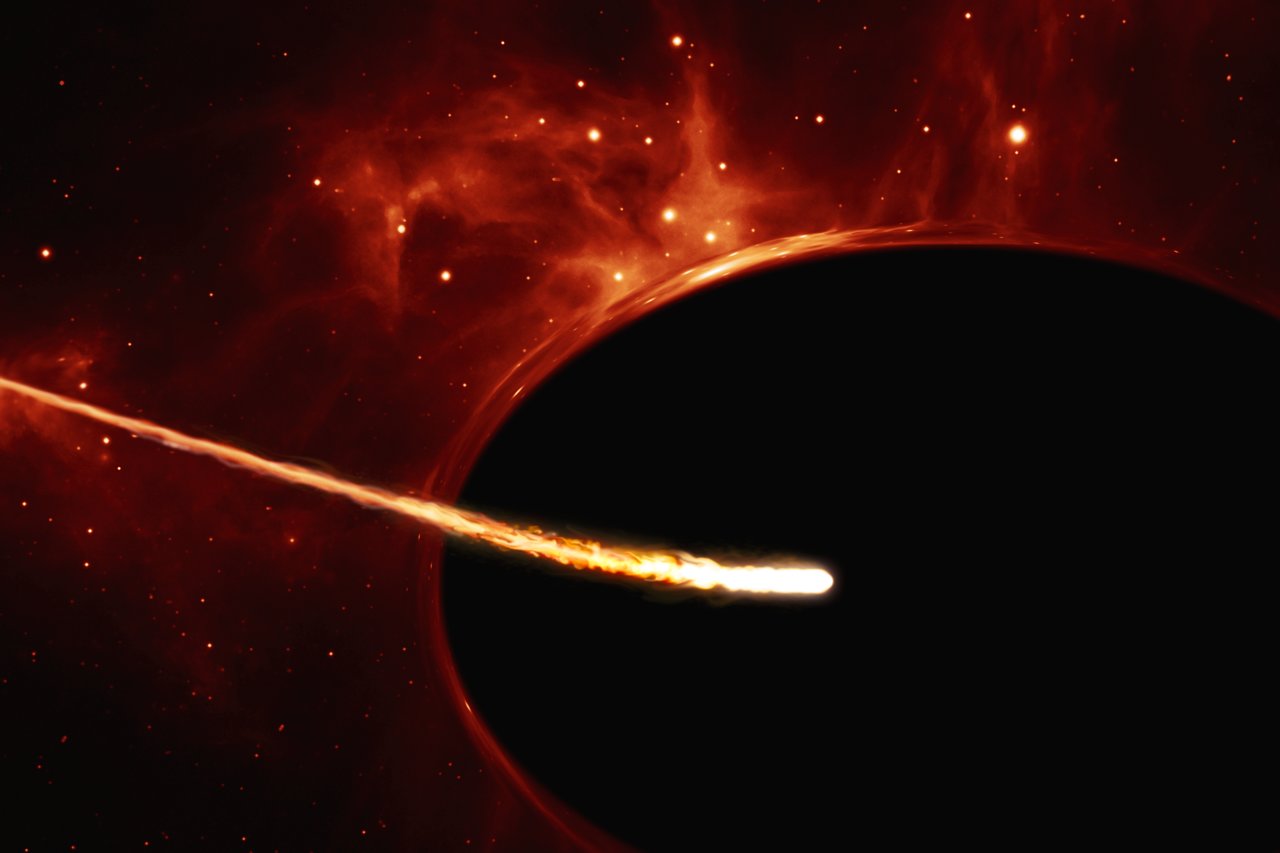
At the center of our galaxy resides a Supermassive Black Hole (SMBH) known as Sagittarius A. Based on ongoing observations, astronomers have determined that this SMBH measures 44 million km (27.34 million mi) in diameter and has an estimated mass of 4.31 million Solar Masses. On occasion, a star will wander too close to Sag A and be torn apart in a violent process known as a tidal disruption event (TDE).
These events cause the release of bright flares of radiation, which let astronomers know that a star has been consumed. Unfortunately, for decades, astronomers have been unable to distinguish these events from other galactic phenomena. But thanks to a new study from by an international team of astrophysicists, astronomers now have a unified model that explains recent observations of these extreme events.
The study – which recently appeared in the Astrophysical Journal Letters under the title “A Unified Model for Tidal Disruption Events” – was led by Dr. Jane Lixin Dai, a physicist with the Niels Bohr Institute’s Dark Cosmology Center. She was joined by members from University of Maryland’s Joint Space-Science Institute and the University of California Santa Cruz (UCSC).
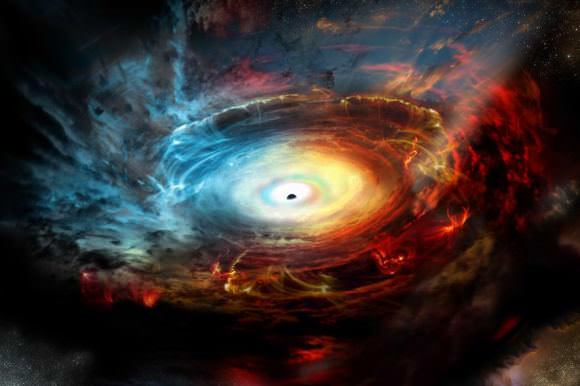
As Enrico Ramirez-Ruiz – the professor and chair of astronomy and astrophysics at UC Santa Cruz, the Niels Bohr Professor at the University of Copenhagen, and a co-author on the paper – explained in a UCSC press release:
“Only in the last decade or so have we been able to distinguish TDEs from other galactic phenomena, and the new model will provide us with the basic framework for understanding these rare events.”
In most galaxies, SMBHs do not actively consume any material and therefore do not emit any light, which distinguishes them from galaxies that have Active Galactic Nuclei (AGNs). Tidal disruption events are therefore rare, occurring only once about every 10,000 years in a typical galaxy. However, when a star does get torn apart, it results in the release of an intense amount of radiation. As Dr. Dai explained:
“It is interesting to see how materials get their way into the black hole under such extreme conditions. As the black hole is eating the stellar gas, a vast amount of radiation is emitted. The radiation is what we can observe, and using it we can understand the physics and calculate the black hole properties. This makes it extremely interesting to go hunting for tidal disruption events.”
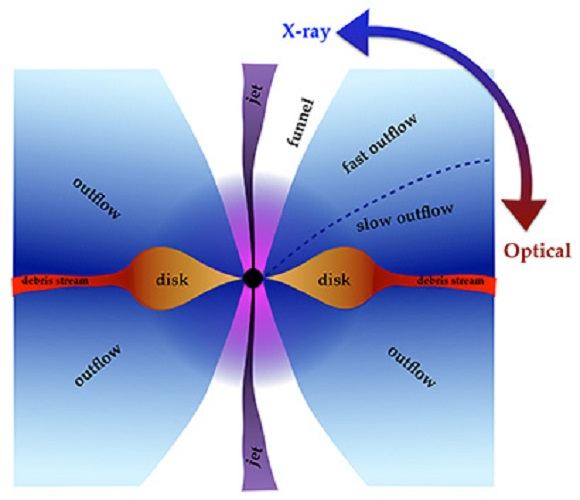
In the past few years, a few dozen candidates for tidal disruption events (TDEs) have been detected using wide-field optical and UV transient surveys as well as X-ray telescopes. While the physics are expected to be the same for all TDEs, astronomers have noted that a few distinct classes of TDEs appear to exist. While some emit mostly x-rays, others emit mostly visible and ultraviolet light.
As a result, theorists have struggled to understand the diverse properties observed and create a coherent model that can explain them all. For the sake of their model, Dr. Dai and her colleagues combined elements from general relativity, magnetic fields, radiation, and gas hydrodynamics. The team also relied on state-of-the-art computational tools and some recently-acquired large computer clusters funded by the Villum Foundation for Jens Hjorth (head of DARK Cosmology Center), the U.S. National Science Foundation and NASA.
Using the model that resulted, the team concluded that it is the viewing angle of the observer that accounts for the differences in observation. Essentially, different galaxies are oriented randomly with respect to observers on Earth, who see different aspects of TDEs depending on their orientation. As Ramirez-Ruiz explained:
“It is like there is a veil that covers part of a beast. From some angles we see an exposed beast, but from other angles we see a covered beast. The beast is the same, but our perceptions are different.”
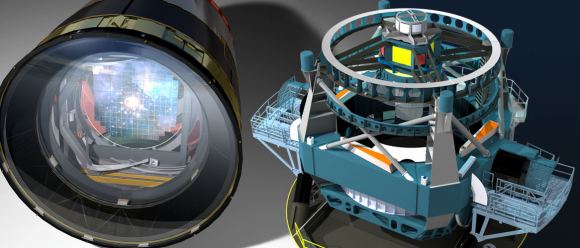
In the coming years, a number of planned survey projects are expected to provide much more data on TDEs, which will help expand the field of research into this phenomena. These include the Young Supernova Experiment (YSE) transient survey, which will be led by the DARK Cosmology Center at the Niels Bohr Institute and UC Santa Cruz, and the Large Synoptic Survey Telescopes (LSST) being built in Chile.
According to Dr. Dai, this new model shows what astronomers can expect to see when viewing TDEs from different angles and will allow them to fit different events into a coherent framework. “We will observe hundreds to thousands of tidal disruption events in a few years,” she said. “This will give us a lot of ‘laboratories’ to test our model and use it to understand more about black holes.”
This improved understanding of how black holes occasionally consume stars will also provide additional tests for general relativity, gravitational wave research, and help astronomers to learn more about the evolution of galaxies.
Further Reading: UCSC, Astrophysical Journal Letters

In August of 2017, a major breakthrough occurred when scientists at the Laser Interferometer Gravitational-Wave Observatory (LIGO) detected gravitational waves that were believed to be caused by the collision of two neutron stars. This source, known as GW170817/GRB, was the first gravitational wave (GW) event that was not caused by the merger of two black holes, and was even believed to have led to the formation of one.
As such, scientists from all over the world have been studying this event ever since to learn what they can from it. For example, according to a new study led by the McGill Space Institute and Department of Physics, GW170817/GRB has shown some rather strange behavior since the two neutron stars colliding last August. Instead of dimming, as was expected, it has been gradually growing brighter.
The study that describes the team’s findings, titled “Brightening X-Ray Emission from GW170817/GRB 170817A: Further Evidence for an Outflow“, recently appeared in The Astrophysical Journal Letters. The study was led by John Ruan of McGill University’s Space Institute and included members from the Canadian Institute for Advanced Research (CIFAR), Northwestern University, and the Leicester Institute for Space and Earth Observation.
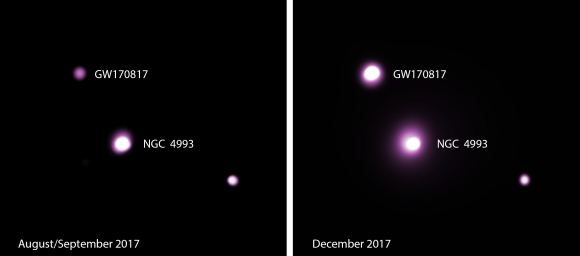
For the sake of their study, the team relied on data obtained by NASA’s Chandra X-ray Observatory, which showed that the remnant has been brightening in the X-ray and radio wavelengths in the months since the collision took place. As Daryl Haggard, an astrophysicist with McGill University whose research group led the new study, said in a recent Chandra press release:
“Usually when we see a short gamma-ray burst, the jet emission generated gets bright for a short time as it smashes into the surrounding medium – then fades as the system stops injecting energy into the outflow. This one is different; it’s definitely not a simple, plain-Jane narrow jet.”
What’s more, these X-ray observations are consistent with radiowave data reported last month by another team of scientists, who also indicated that it was continuing to brighten during the three months since the collision. During this same period, X-ray and optical observatories were unable to monitor GW170817/GRB because it was too close to the Sun at the time.
However, once this period ended, Chandra was able to gather data again, which was consistent with these other observations. As John Ruan explained:
“When the source emerged from that blind spot in the sky in early December, our Chandra team jumped at the chance to see what was going on. Sure enough, the afterglow turned out to be brighter in the X-ray wavelengths, just as it was in the radio.”

This unexpected behavior has led to a serious buzz in the scientific community, with astronomers trying to come up with explanations as to what type of physics could be driving these emissions. One theory is a complex model for neutron star mergers known as “cocoon theory”. In accordance with this theory, the merger of two neutron stars could trigger the release of a jet that shock-heats the surrounding gaseous debris.
This hot “cocoon” around the jet would glow brightly, which would explain the increase in X-ray and radiowave emissions. In the coming months, additional observations are sure to be made for the sake of confirming or denying this explanation. Regardless of whether or not the “cocoon theory” holds up, any and all future studies are sure to reveal a great deal more about this mysterious remnant and its strange behavior.
As Melania Nynka, another McGill postdoctoral researcher and a co-author on the paper indicated, GW170817/GRB presents some truly unique opportunities for astrophysical research. “This neutron-star merger is unlike anything we’ve seen before,” she said. “For astrophysicists, it’s a gift that seems to keep on giving.”
It is no exaggeration to say that the first-ever detection of gravitational waves, which took place in February of 2016, has led to a new era in astronomy. But the detection of two neutron stars colliding was also a revolutionary accomplishment. For the first time, astronomers were able to observe such an event in both light waves and gravitational waves.
In the end, the combination of improved technology, improved methodology, and closer cooperation between institutions and observatories is allowing scientists to study cosmic phenomena that was once merely theoretical. Looking ahead, the possibilities seem almost limitless!
Further Reading: Chandra X-Ray Observatory, The Astrophysical Journal Letters
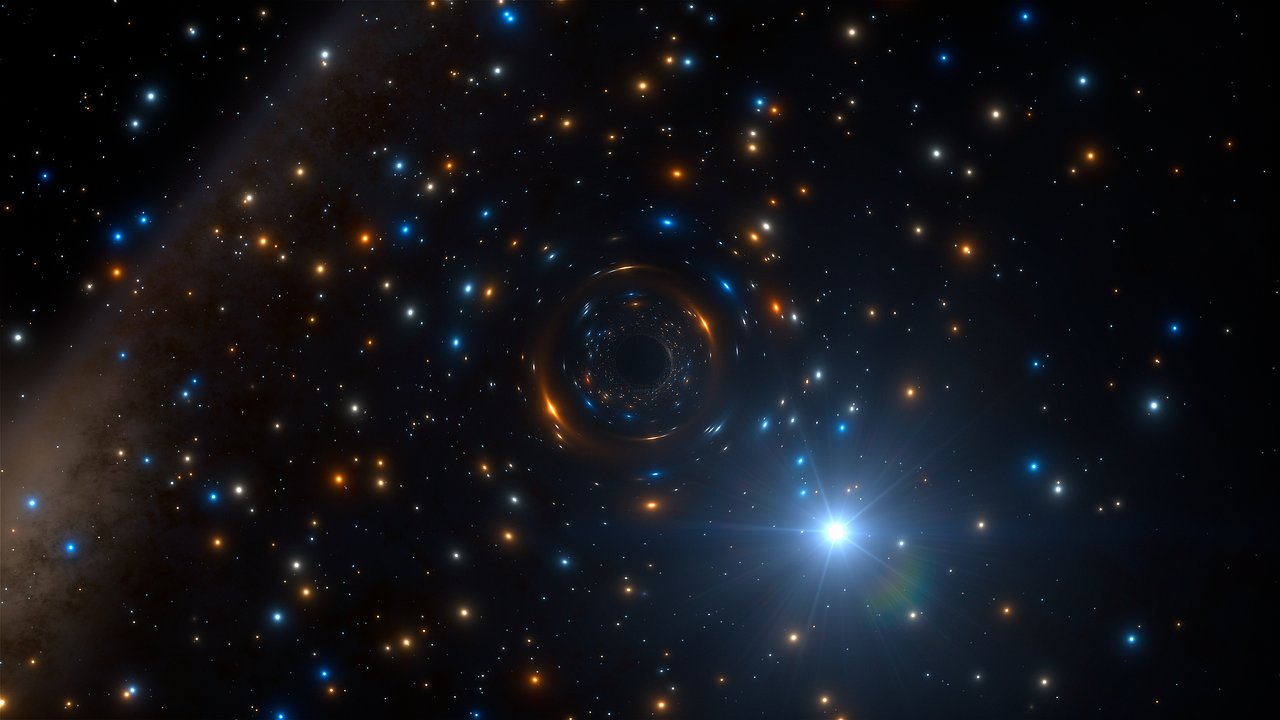
Astronomers have been fascinated with globular clusters ever since they were first observed in 17th century. These spherical collections of stars are among the oldest known stellar systems in the Universe, dating back to the early Universe when galaxies were just beginning to grow and evolve. Such clusters orbit the centers of most galaxies, with over 150 known to belong to the Milky Way alone.
One of these clusters is known as NGC 3201, a cluster located about 16,300 light years away in the southern constellation of Vela. Using the ESO’s Very Large Telescope (VLT) at the Paranal Observatory in Chile, a team of astronomers recently studied this cluster and noticed something very interesting. According to the study they released, this cluster appears to have a black hole embedded in it.
The study appeared in the Monthly Notices of the Royal Astronomical Society under the title “A detached stellar-mass black hole candidate in the globular cluster NGC 3201“. The study was led by Benjamin Giesers of the Georg-August-University of Göttingen and included members from Liverpool John Moores University, Queen Mary University of London, the Leiden Observatory, the Institute of Astrophysics and Space Sciences, ETH Zurich, and the Leibniz Institute for Astrophysics Potsdam (AIP).
For the sake of their study, the team relied on the Multi Unit Spectroscopic Explorer (MUSE) instrument on the VLT to observe NGC 3201. This instrument is unique because of the way it allows astronomers to measure the motions of thousands of far away stars simultaneously. In the course of their observations, the team found that one of the cluster’s stars was being flung around at speeds of several hundred kilometers an hour and with a period of 167 days.
As Giesers explained in an ESO press release:
“It was orbiting something that was completely invisible, which had a mass more than four times the Sun — this could only be a black hole! The first one found in a globular cluster by directly observing its gravitational pull.”
This finding was rather unexpected, and constitutes the first time that astronomers have been able to detect an inactive black hole at the heart of a globular cluster – meaning that it is not currently accreting matter or surrounded by a glowing disc of gas. They were also able to estimate the black hole’s mass by measuring the movements of the star around it and thus extrapolating its enormous gravitational pull.
From its observed properties, the team determined that the rapidly-moving star is about 0.8 times the mass of our Sun and the mass of its black hole counterpart to be around 4.36 times the Sun’s mass. This put’s it in the “stellar-mass black hole” category, which are stars that exceeds the maximum mass allowance of a neutron star, but are smaller than supermassive black holes (SMBHs) – which exist at the centers of most galaxies.
This finding is highly significant, and not just because it was the first time that astronomers have observed a stellar-mass black hole in a globular cluster. In addition, it confirms what scientists have been suspecting for a few years now, thanks to recent radio and x-ray studies of globular clusters and the detection of gravity wave signals. Basically, it indicates that black holes are more common in globular clusters than previously thought.
“Until recently, it was assumed that almost all black holes would disappear from globular clusters after a short time and that systems like this should not even exist!” said Giesers. “But clearly this is not the case – our discovery is the first direct detection of the gravitational effects of a stellar-mass black hole in a globular cluster. This finding helps in understanding the formation of globular clusters and the evolution of black holes and binary systems – vital in the context of understanding gravitational wave sources.”
This find was also significant given that the relationship between black holes and globular clusters remains a mysterious, but highly important one. Due to their high masses, compact volumes, and great ages, astronomers believe that clusters have produced a large number of stellar-mass black holes over the course of the Universe’s history. This discovery could therefore tell us much about the formation of globular clusters, black holes, and the origins of gravitational wave events.
And be sure to enjoy this ESO podcast explaining the recent discovery:
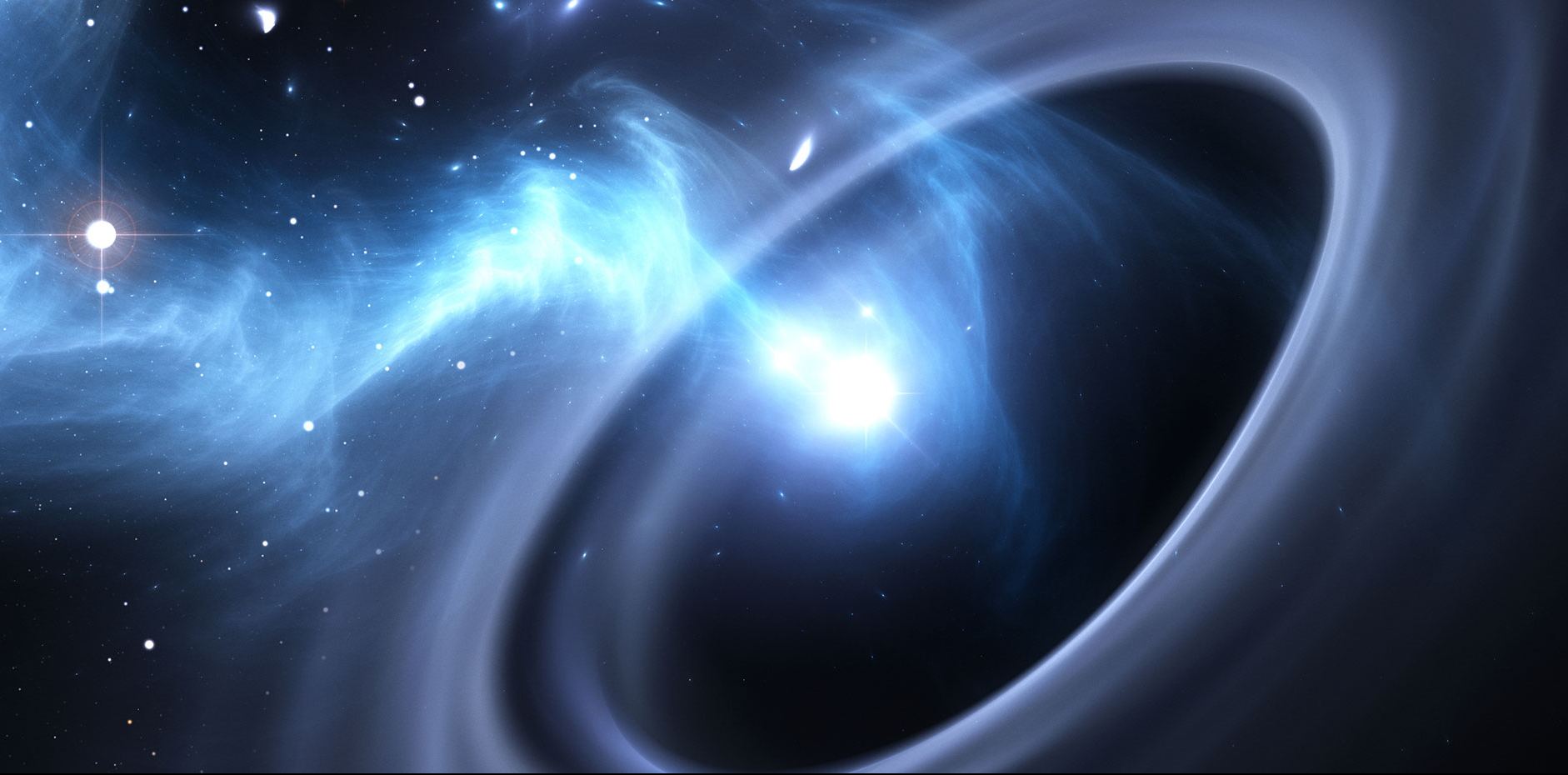
Black holes have been an endless source of fascination ever since Einstein’s Theory of General Relativity predicted their existence. In the past 100 years, the study of black holes has advanced considerably, but the awe and mystery of these objects remains. For instance, scientists have noted that in some cases, black holes have massive jets of charged particles emanating from them that extend for millions of light years.
These “relativistic jets” – so-named because they propel charged particles at a fraction of the speed of light – have puzzled astronomers for years. But thanks to a recent study conducted by an international team of researchers, new insight has been gained into these jets. Consistent with General Relativity, the researchers showed that these jets gradually precess (i.e. change direction) as a result of space-time being dragged into the rotation of the black hole.
Their study, titled “Formation of Precessing Jets by Tilted Black Hole Discs in 3D General Relativistic MHD Simulations“, recently appeared in the Monthly Notices of the Royal Astronomical Society. The team consisted of members from the at Northwestern University.
For the sake of their study, the team conducted simulations using the Blue Waters supercomputer at the University of Illinois. The simulations they conducted were the first ever to model the behavior of relativistic jets coming from Supermassive Black Holes (SMBHs). With close to a billion computational cells, it was also the highest-resolution simulation of an accreting black hole ever achieved.
As Alexander Tchekhovskoy, an assistant professor of physics and astronomy at Northwestern’s Weinberg College of Arts and Sciences, explained in a recent Northwestern Now press release:
“Understanding how rotating black holes drag the space-time around them and how this process affects what we see through the telescopes remains a crucial, difficult-to-crack puzzle. Fortunately, the breakthroughs in code development and leaps in supercomputer architecture are bringing us ever closer to finding the answers.”
Much like all Supermassive Black Holes, rapidly spinning SMBHs regularly engulf (aka. accrete) matter. However, rapidly spinning black holes are also known for the way they emit energy in the form of relativistic jets. The matter that feeds these black holes forms a rotating disk around them – aka. an accretion disk – which is characterized by hot, energized gas and magnetic field lines.
It is the presence of these field lines that allows black holes to propel energy in the form of these jets. Because these jets are so large, they are easier to study than the black holes themselves. In so doing, astronomers are able to understand how quickly the direction of these jets change, which reveals things about the rotation of the black holes themselves – such as the orientation and size of their rotating disks.
Advanced computer simulations are necessary when it comes to the study of black holes, largely because they are not observable in visible light and are typically very far away. For instance, the closest SMBH to Earth is Sagittarius A*, which is located about 26,000 light-years away at the center of our galaxy. As such, simulations are the only way to determine how a highly complex system like a black hole operates.
In previous simulations, scientists operated under the assumption that black hole disks were aligned. However, most SMBHs have been found to have tilted disks – i.e. the disks rotate around a separate axis than the black hole itself. This study was therefore seminal in that it showed how disks can change direction relative to their black hole, leading to precessing jets that periodically change their direction.
This was previously unknown because of the incredibly amount of computing power that is needed to construct 3-D simulations of the region surrounding a rapidly spinning black hole. With the support of a National Science Foundation (NSF) grant, the team was able to achieve this by using the Blue Waters, one of the largest supercomputers in the world.

With this supercomputer at their disposal, the team was able to construct the first black hole simulation code, which they accelerated using graphical processing units (GPUs). Thanks to this combination, the team was able to carry out simulations that had the highest level of resolution ever achieved – i.e. close to a billion computational cells. As Tchekhovskoy explained:
“The high resolution allowed us, for the first time, to ensure that small-scale turbulent disk motions are accurately captured in our models. To our surprise, these motions turned out to be so strong that they caused the disk to fatten up and the disk precession to stop. This suggests that precession can come about in bursts.”
The precession of relativistic jets could explain why light fluctuations have been observed coming from around black holes in the past – which are known as quasi-periodic oscillations (QPOs). These beams, which were first discovered by Michiel van der Klis (one of the co-authors on the study), operate in much the same way as a quasar’s beams, which appear to have a strobing effect.
This study is one of many that is being conducting on rotating black holes around the world, the purpose of which is to gain a better understanding about recent discoveries like gravitational waves, which are caused by the merger of black holes. These studies are also being applied to observations from the Event Horizon Telescope, which captured the first images of Sagittarius A*’s shadow. What they will reveal is sure to excite and amaze, and potentially deepen the mystery of black holes.
In the past century, the study of black holes has advanced considerably – from the purely theoretical, to indirect studies of the effects they have on surrounding matter, to the study of gravitational waves themselves. Perhaps one day, we might actually be able to study them directly or (if it’s not too much to hope for) peer directly inside them!
Further Reading: Northwestern Now, MNRAS

In February of 2016, scientists from the Laser Interferometer Gravitational-Wave Observatory (LIGO) announced the first-ever detection of gravitational waves. A little over a century after they were first predicted by Einstein’s Theory of General Relativity, we finally had proof that this phenomenon existed. In August of 2017, another major breakthrough occurred when LIGO detected waves that were believed to be caused by a neutron star merger.
Shortly thereafter, scientists at LIGO, Advanced Virgo, and the Fermi Gamma-ray Space Telescope were able to determine where in the sky the neutron star merger occurred. While many studies have focused on the by-products of this merger, a new study by researchers from Trinity University, the University of Texas at Austin and Eureka Scientific, has chosen to focus on the remnant, which they claim is likely a black hole.
For the sake of their study, which recently appeared online under the title “GW170817 Most Likely Made a Black Hole“, the team consulted data from the Chandra X-ray Observatory to examine what resulted of the supernova merger. This data was obtained during Director’s Discretionary Time observations that were made on December 3rd and 6th, 2017, some 108 days after the merger.
This data showed a light-curve increase in the X-ray band which was compatible to the radio flux increase that was reported by a previous study conducted by the same team. These combined results suggest that radio and X-ray emissions were being produced at the same source, and that the rising light-curve that followed the merger was likely due to an increase in accelerated charged particles in the external shock – the region where an outflow of gas interacts with the interstellar medium.
As they indicate in their study, this could either be explained as the result of a more massive neutron star being formed from the merger, or a black hole:
“The merger of two neutron stars with mass 1.48 ± 0.12 M and 1.26 ± 0.1 M — where the merged object has a mass of 2.74 +0.04-0.01 M… could result in either a neutron star or a black hole. There might also be a debris disk that gets accreted onto the central object over a period of time, and which could be source of keV X-rays.”
The team also ruled out various possibilities of what could account for this rise in X-ray luminosity. Basically, they concluded that the X-ray photons were not coming from a debris disk, which would have been left over from the merger of the two neutron stars. They also deduced that they would not be produced by a relativistic jet spewing from the remnant, since the flux would be much lower after 102 days.

All of this indicated that the remnant was more likely to be a black hole than a hyper-massive neutron star. As they explained:
“We show next that if the merged object were a hyper-massive neutron star endowed with a strong magnetic field, then the X-ray luminosity associated with the dipole radiation would be larger than the observed luminosity 10 days after the event, but much smaller than the observed flux at t ~ 100 days. This argues against the formation of a hyper-massive neutron star in this merger.”
Last, but not least, they considered the X-ray and radio emissions that were present roughly 100 days after the merger. These, they claim, are best explained by continued emissions coming from the merger-induced shock (and the not remnant itself) since these emissions would continue to propagate in the interstellar medium around the remnant. Combined with early X-ray data, this all points towards GW170817 now being a black hole.
The first-ever detection of gravitational waves signaled the dawn of a new era in astronomical research. Since that time, observatories like LIGO, Advanced Virgo, and GEO 600 have also benefited from information-sharing and new studies that have indicated that mergers are more common than previously thought, and that gravity waves could be used to probe the interior of supernovae.
With this latest study, scientists have learned that they are not only able to detect the waves caused by black hole mergers, but even the creation thereof. At the same time, it shows how the study of the Universe is growing. Not only is astronomy advancing to the point where we are able to study more and more of the visible Universe, but the invisible Universe as well.
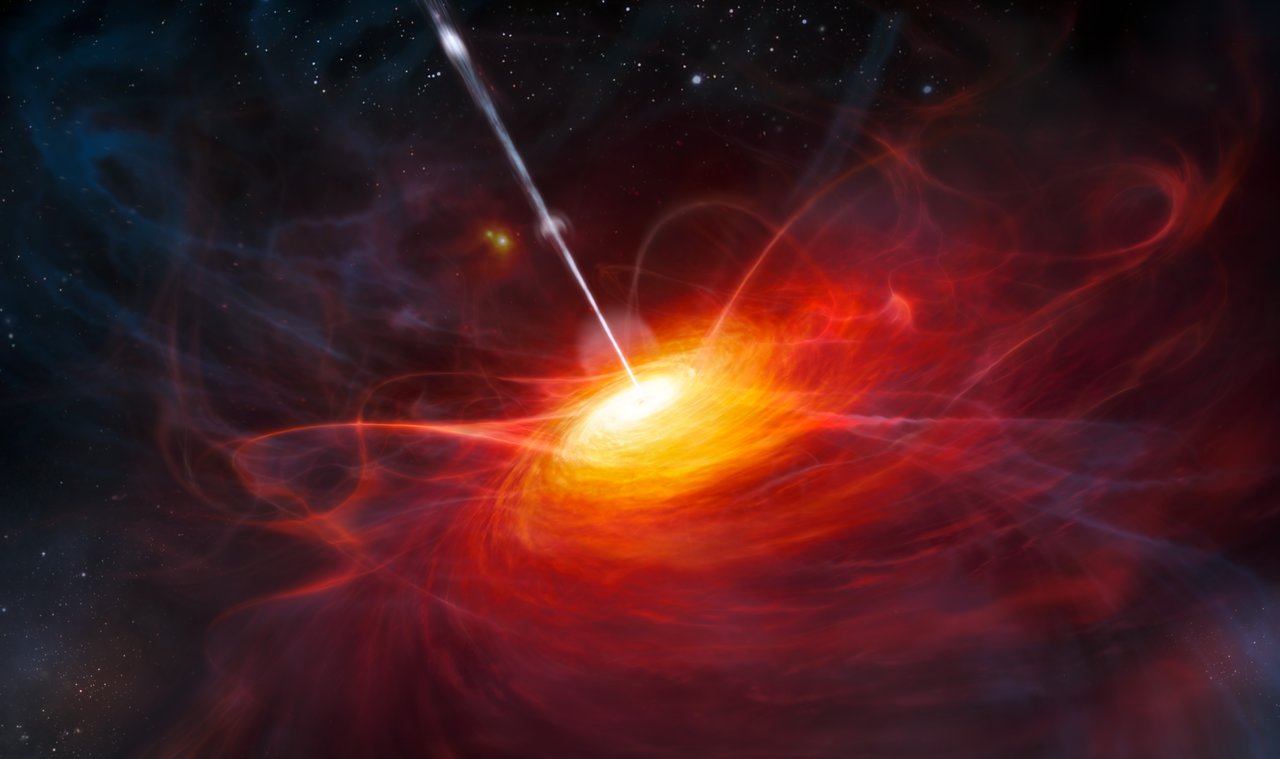
Ever since the discovery of Sagittarius A* at the center of our galaxy, astronomers have come to understand that most massive galaxies have a Supermassive Black Hole (SMBH) at their core. These are evidenced by the powerful electromagnetic emissions produced at the nuclei of these galaxies – which are known as “Active Galatic Nuclei” (AGN) – that are believed to be caused by gas and dust accreting onto the SMBH.
For decades, astronomers have been studying the light coming from AGNs to determine how large and massive their black holes are. This has been difficult, since this light is subject to the Doppler effect, which causes its spectral lines to broaden. But thanks to a new model developed by researchers from China and the US, astronomers may be able to study these Broad Line Regions (BLRs) and make more accurate estimates about the mass of black holes.
The study, “Tidally disrupted dusty clumps as the origin of broad emission lines in active galactic nuclei“, recently appeared in the scientific journal Nature. The study was led by Jian-Min Wang, a researcher from the Institute of High Energy Physics (IHEP) at the Chinese Academy of Sciences, with assistance from the University of Wyoming and the University of Nanjing.
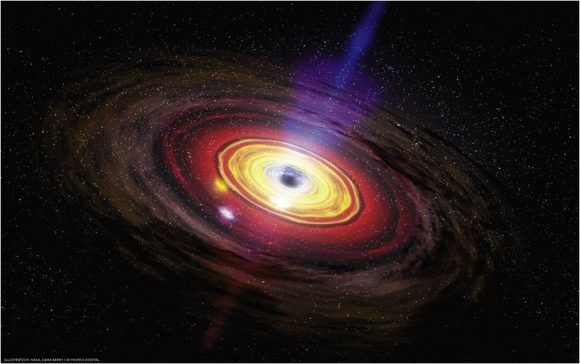
To break it down, SMBHs are known for having a torus of gas and dust that surrounds them. The black hole’s gravity accelerates gas in this torus to velocities of thousands of kilometers per second, which causes it to heat up and emit radiation at different wavelengths. This energy eventually outshined the entire surrounding galaxy, which is what allows astronomers to determine the presence of an SMBH.
As Michael Brotherton, a UW professor in the Department of Physics and Astronomy and a co0author on the study, explained in a UW press release:
“People think, ‘It’s a black hole. Why is it so bright?’ A black hole is still dark. The discs reach such high temperatures that they put out radiation across the electromagnetic spectrum, which includes gamma rays, X-rays, UV, infrared and radio waves. The black hole and surrounding accreting gas the black hole is feeding on is fuel that turns on the quasar.”
The problem with observing these bright regions comes from the fact that the gases within them are moving so quickly in different directions. Whereas gas moving away (relative to us) is shifted towards the red end of the spectrum, gas that is moving towards us is shifted towards the blue end. This is what leads to a Broad Line Region, where the spectrum of the emitted light becomes more like a spiral, making accurate readings difficult to obtain.
Currently, the measurement of the mass of SMBHs in active galactic nuclei relies the “reverberation mapping technique”. In short, this involves using computer models to examine the symmetrical spectral lines of a BLR and measuring the time delays between them. These lines are believed to arise from gas that has been photoionized by the gravitational force of the SMBH.
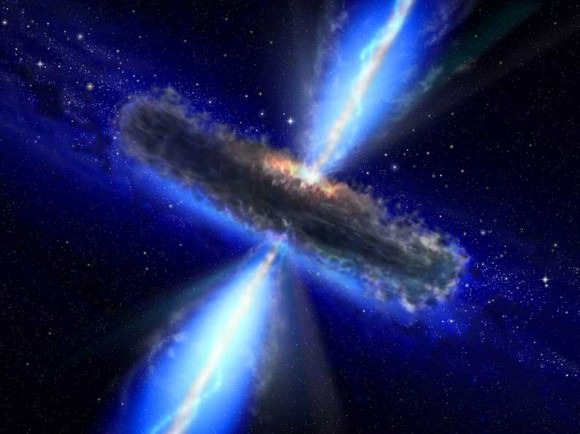
However, since there is little understanding of broad emission lines and the different components of BLRs, this method gives rise to some uncertainties off between 200 and 300%. “We are trying to get at more detailed questions about spectral broad-line regions that help us diagnose the black hole mass,” said Brotherton. “People don’t know where these broad emission line regions come from or the nature of this gas.”
In contrast, the team led by Dr. Wang adopted a new type of computer model that considered the dynamics of the gas torus surrounding a SMBH. This torus, they assume, would be made up of discrete clumps of matter that would be tidally disrupted by the black hole, resulting in some gas flowing into it (aka. accreting on it) and some being ejected as outflow.
From this, they found that the emission lines in a BLR are subject to three characteristics – “asymmetry”, “shape” and “shift”. After examining various emissions lines – both symmetrical and asymmetrical – they found that these three characteristics were strongly dependent on how bright the gas clumps were, which they interpreted as being a result of the angle of their motion within the torus. Or as Dr. Brotherton put it:
“What we propose happens is these dusty clumps are moving. Some bang into each other and merge, and change velocity. Maybe they move into the quasar, where the black hole lives. Some of the clumps spin in from the broad-line region. Some get kicked out.”

Credit: NRAO/AUI/NSF
In the end, their new model suggests that tidally disrupted clumps of matter from a black hole torus may represent the source of the BLR gas. Compared to previous models, the one devised by Dr. Wang and his colleagues establishes a connection between different key processes and components in the vicinity of a SMBH. These include the feeding of the black hole, the source of photoionized gas, and the dusty torus itself.
While this research does not resolve all the mysteries surrounding AGNs, it is an important step towards obtaining accurate mass estimates of SMBHs based on their spectral lines. From these, astronomers could be able to more accurately determine what role these black holes played in the evolution of large galaxies.
The study was made possible thanks with support provided by the National Key Program for Science and Technology Research and Development, and the Key Research Program of Frontier Sciences, both of which are administered by the Chinese Academy of Sciences.